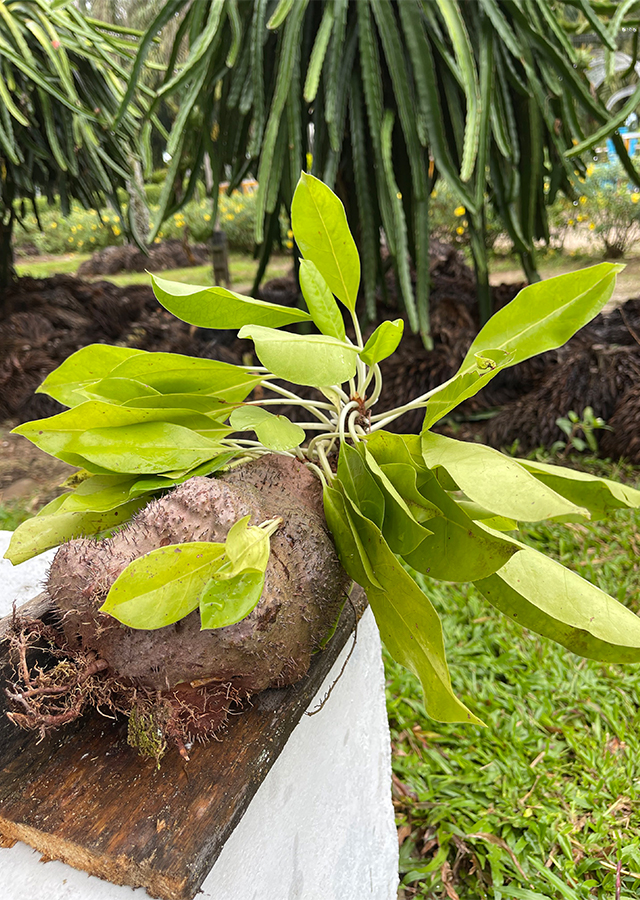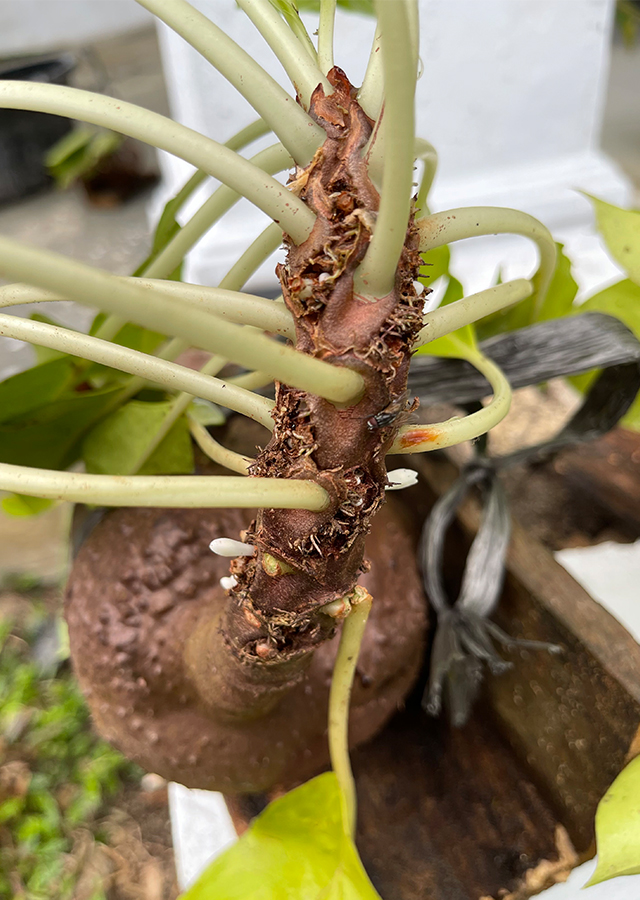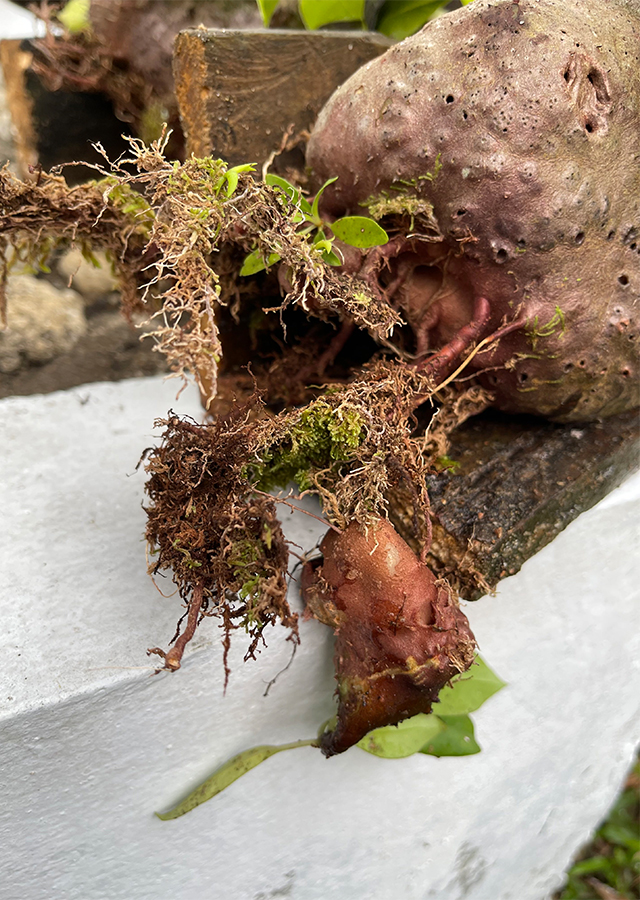Ant Plant
Myrmecodia pendens Merr. & L.M.Perry
Rubiaceae
Location in our garden
Principal



Synonym
-
Habitus
Shrubs. Epiphytes that are about 50 cm long, grow hanging or attached to host trees and associate with ants
Part Used
Tuber
Growing Requirements
Full Sunshine
Habitat
Forest
Coastal
Grassland
Overview
Ant-plant is one of the original medicinal plants from Merauke Regency, Papua Province. This plant is also widely distributed in the equatorial region of the world, including Indonesia (Kalimantan, Sumatra), Papua New Guinea, the Philippines, Cambodia, Cape York, and the Solomon Islands. Ant plant have a uniqueness that lies in the interaction of ants that make the tunnels in the tubers as their nests and form colonies. This uniqueness is thought to cause the ant plant to contain ingredients that can be used as medicinal plants, where traditionally, this plant has been used by indigenous Papuans for generations to treat various diseases.
Vernacular Names
No information found. Need further search.
Agroecology
This plant is commonly found in mangrove forests and trees around the coast at an altitude of 2,400 m above sea level. Besides these areas, this plant is also often found in grassland areas and open agricultural areas, with an altitude of about 600 m above sea level and is rarely found in lowland tropical forests. This plant grows attached to a host that has a trunk with a rough stature, lush tree stature, open area, and close to the river (a bit damp). In the Regions of Papua, Sumatra, and Kalimantan, this plant is generally found as an epiphyte on several trees such as eucalyptus trees, kaha, beech trees, fir trees, tamarind trees, gala-gala trees, bayuan trees, kasturi trees, pulai, banyan, and so on. The host trees of this plant are generally scattered throughout the tropics, namely areas that have high abiotic factors with high rainfall, air temperature, air humidity and light intensity, soil and physiographic conditions of the tropical environment.
Morphology
- Roots - attached to the host tree, dangling on the branches of plants.
- Stems - thick, unbranched, short internodes, brown to grayish, bulging at the base of the stem (hypocotyl) resembling a tuber, round when young, then becomes oblong, shortens or elongates when old. The inside of the hollow stem is insulated, resembling a labyrinth and is usually used as a habitat for ant colonies. This tuber-like stem is sometimes attached to the host plant, sometimes hanging. Wrapped in klipeoli and alveoli that have spines that serve to protect them from herbivorous predators.
- Leaves - single, stemmed arranged spread but more gathered at the end of the stem and green. The leaves are thick, oblong-shaped with a blunt base and a tapered tip, flat edges, smooth leaf surface, white veins.
- Flowers - white, the petals are generally split at the ends.
- Fruits - berry-shaped, round, and orange.
- Seeds - generally contain 2 seeds in each fruit.
Cultivation
Propagated by seeds and in vitro.
Chemical Constituents
Flavonoid, tanin, tokoferol, alfa-tokoferol, fenolik, dan berbagai mineral (natrium, kalsium, seng, besi, fosfor, magnesium), polisakarida.
Traditional Medicinal Uses
- Cure inflammation.
- Overcome muscle pain, coronary heart problems, cancer and tumors (cancer of the brain, nose, breast, liver, lung, intestine, uterus, skin, prostate, and blood cancer), diabetes, goiter, nosebleeds, stomach ulcers, hemorrhoids, tuberculosis, rheumatism, uric acid disorders, stroke, ulcers, impaired kidney function.
- Facilitate breast milk, menstruation and overcome vaginal discharge.
- Increase sexual arousal for men and women.
- Has activity as anti-inflammatory, antioxidant, anticancer, and antibacterial.
Part Used
Reference Sources
- Royal Botanic Gardens. Plants of the World Online: Myrmecodia pendens Merr. & L.M.Perry. https://powo.science.kew.org/taxon/urn:lsid:ipni.org:names:328917-2. 28-04-22.
- Dinas Kesehatan Provinsi Papua. 2016. Tumbuhan Obat Tradisional Papua: Berdasarkan Kearifan Lokal Masyarakat. Nulis Buku Jendela Dunia.
- Kusumanegara A., Pribadi E. Y., Jannah A. M., Yuniar N., Utomo H. S., Ngara D. A. N. 2020. Menyingkap Rahasia Jenis-Jenis Tumbuhan Obat di Taman Nasional Matalawa Sumba-Nusa Tenggara Timur. Balai Taman Nasional Manupeu Tanah Daru dan Laiwangi Wanggameti.
- Wabia E., Siburian R. H. S. 2019. Profil Tempat Tumbuh Sarang Semut (Myrmecodia spp.) di Distrik Manokwari Selatan Papua Barat. EnviroScienteae 15(1): 91-94.
- Crisnaningtyas F., Rachmadi A. T. 2010. Pemanfaatan Sarang Semut (Myrmecodia pendens) Asal Kalimantan Selatan Sebagai Antibakteri. Jurnal Riset Industri Hasil Hutan 2(2): 31 - 35.
- Nugroho R. A. dkk. 2019. Myrmecodia: Efek Fisiologi dan Potensi Manfaat. Deepublish.
